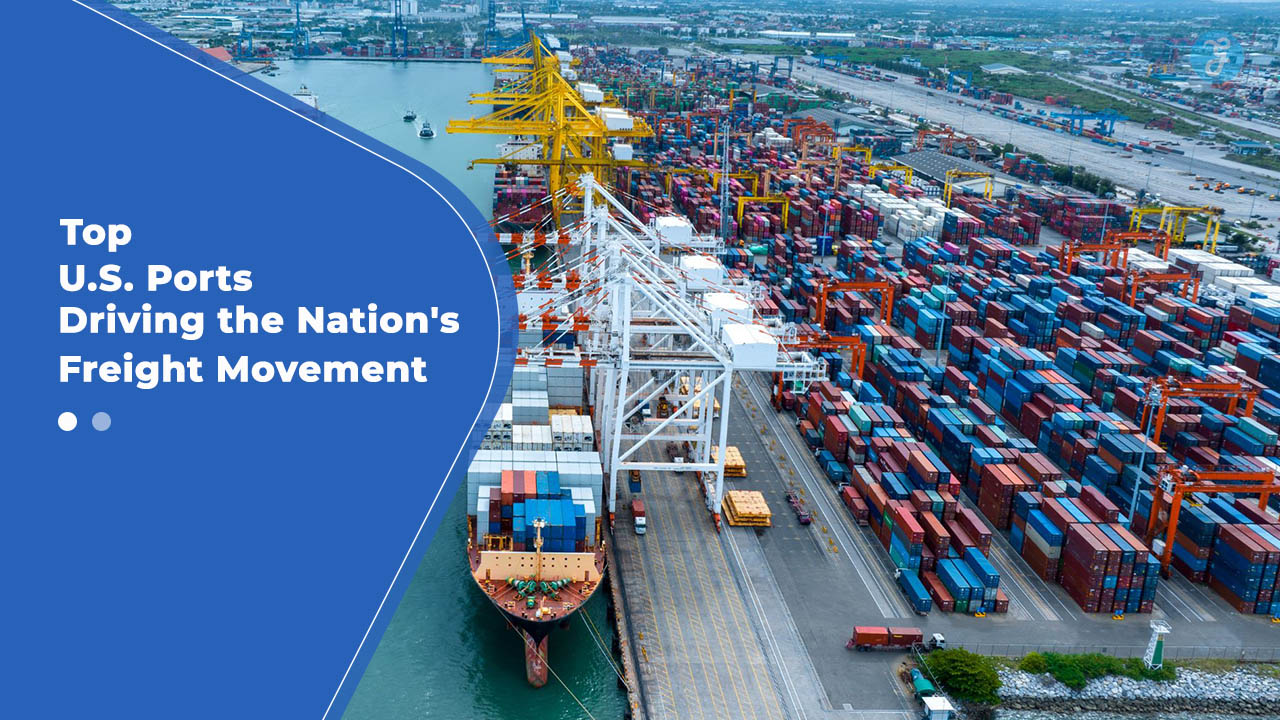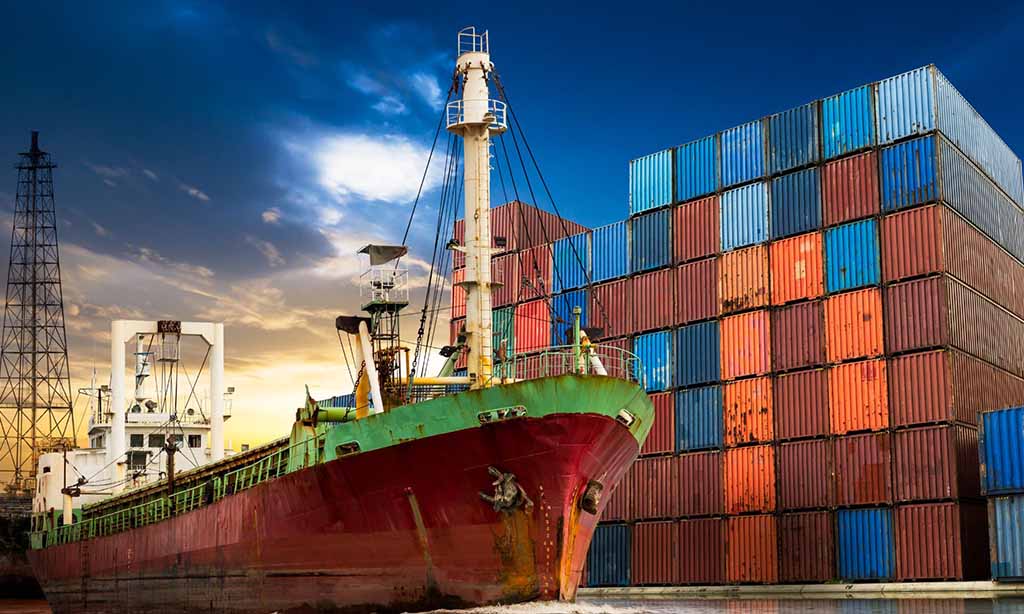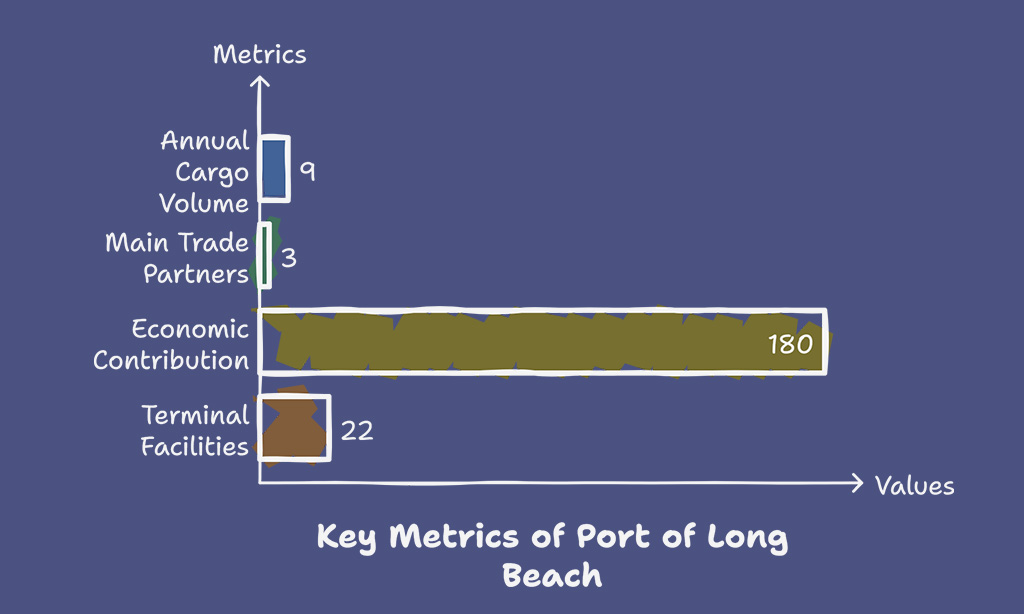The United States is a global trade powerhouse, and its ports play a crucial role in facilitating the movement of goods domestically and internationally.
With over 360 commercial ports nationwide, only a handful stand out as the most efficient and high-volume hubs supporting the U.S. supply chain.
These ports serve as gateways to the world, handling billions of dollars in cargo annually, supporting various industries, and ensuring the seamless distribution of essential goods across the country.
This article explores the top 5 U.S. ports driving the nation’s freight movement, shedding light on their significance, cargo capacity, infrastructure, and economic contributions.
These ports not only ensure seamless logistics but also serve as economic engines, connecting businesses with global markets. Additionally, we will analyze their ongoing advancements, sustainability efforts, and future outlook to understand their long-term impact on the global economy.
The Role of U.S. Ports in Freight Movement
U.S. ports are vital to maintaining the country’s supply chain, supporting industries, and enabling international trade. Here’s why these ports are indispensable:
- Global Trade Gateways: Over 90% of U.S. trade by volume moves through seaports.
- Economic Powerhouses: Ports contribute over $5.4 trillion to the U.S. GDP.
- Employment Generators: Millions of direct and indirect jobs rely on port operations.
- Infrastructure Hubs: Modern ports integrate road, rail, and air logistics for seamless cargo movement.
- Supply Chain Stability: A well-functioning port network prevents disruptions and ensures timely delivery of goods.
Key Factors That Make a Port a Freight Hub
Not all ports are created equal. The leading U.S. ports driving the nation’s freight movement excel in:
- Cargo Volume Handling: Measured in twenty-foot equivalent units (TEUs) for containers.
- Infrastructure Development: Advanced port facilities and deep-water access.
- Connectivity: Direct access to railroads, highways, and airports.
- Technological Advancements: Use of automation, AI, and blockchain for efficiency.
- Operational Efficiency: Reduced turnaround times and streamlined customs processing.
Top 5 U.S. Ports Leading Freight Movement
Let’s get straight into it.
1. Port of Los Angeles – America’s Busiest Cargo Gateway
Located in Southern California, the Port of Los Angeles is the largest and busiest U.S. port. It handles a significant share of America’s freight movement, making it a vital global trade hub. The port’s strategic location and expansive infrastructure allow it to process millions of shipping containers annually, making it a crucial player in trans-Pacific trade. Its ability to handle high container volumes efficiently makes it indispensable for industries ranging from retail to automotive and manufacturing.
Key Statistics:
| Metric | Value |
| Annual Cargo Volume | Over 9.2 million TEUs |
| Main Trade Partners | China, Japan, South Korea |
| Economic Contribution | Supports over 1 million jobs nationwide |
| Terminal Facilities | 25 cargo terminals |
| Land Area | 7,500 acres |
Highlights:
- Technological Advancements: Implements AI-powered logistics to optimize cargo movement.
- Sustainability Efforts: Pioneering zero-emission cargo handling.
- Strategic Expansion: Investing in deep-water infrastructure to accommodate larger vessels.
- Efficient Rail Integration: Direct access to major U.S. railway networks, reducing road congestion.
2. Port of Long Beach – A Powerhouse for Containerized Goods
Adjacent to the Port of Los Angeles, the Port of Long Beach ranks as the second busiest U.S. port, playing a pivotal role in trans-Pacific trade. It specializes in containerized goods and is widely recognized for its cutting-edge sustainability initiatives, positioning itself as a leader in green shipping.
Key Statistics:
| Metric | Value |
| Annual Cargo Volume | Over 9 million TEUs |
| Main Trade Partners | China, Vietnam, Mexico |
| Economic Contribution | Generates over $180 billion in trade annually |
| Green Initiatives | Zero-emission cargo handling goals by 2030 |
| Terminal Facilities | 22 container terminals |
Highlights:
- Sustainability Initiatives: Green Port Policy aimed at reducing emissions.
- Innovative Logistics: Deployment of automated terminals to enhance efficiency.
- Cargo Specialization: Handles a mix of consumer goods, electronics, and automobiles.
- Smart Port Technologies: AI-powered traffic management for streamlined cargo handling.
3. Port of New York & New Jersey – The East Coast’s Shipping Giant
As the busiest port on the East Coast, the Port of New York & New Jersey facilitates significant trade between the U.S. and Europe. Its ideal location serves as a key entry point for goods entering the Eastern Seaboard.
Key Statistics:
| Metric | Value |
| Annual Cargo Volume | Over 8.9 million TEUs |
| Main Trade Partners | Germany, UK, India |
| Economic Contribution | Supports over 500,000 jobs |
| Cargo Specialization | Consumer goods, automobiles |
| Expansion Projects | $2.1 billion investment in port infrastructure |
Highlights:
- Intermodal Connectivity: Direct rail access to key inland markets.
- E-Commerce Boom: Increasing capacity to accommodate rising online shopping trends.
- Infrastructure Expansion: Major dredging projects to accommodate larger ships.
- Automation Enhancements: AI-driven scheduling for vessel berthing and cargo unloading.
4. Port of Savannah – The Fastest-Growing U.S. Port
The Port of Savannah has emerged as the fastest-growing U.S. port, making significant strides in cargo handling efficiency and infrastructure expansion. Strategically located along the southeastern U.S. coastline, it serves as a critical gateway for agricultural exports, retail goods, and manufactured products.
The port is renowned for its rapid turnaround times and seamless intermodal connectivity, making it a top choice for shippers looking for efficiency and reliability.
Key Statistics:
| Metric | Value |
| Annual Cargo Volume | Over 5.4 million TEUs |
| Main Trade Partners | Canada, Europe, Asia |
| Economic Contribution | Over $140 billion in economic impact |
| Infrastructure Growth | Expansion of the Garden City Terminal |
| Rail Connectivity | 2-day rail service to key Midwest markets |
Highlights:
- Expansion Projects: Multi-billion-dollar investments in terminal expansion and rail connectivity.
- Strategic Location: A major distribution hub for the southeastern U.S. market.
- Sustainability Leadership: Implementation of shore power technology and electric cargo-handling equipment.
- Efficiency Focus: Ranked among the most efficient U.S. ports for vessel turnaround time.
5. Port of Houston – Energy and Bulk Cargo Hub
The Port of Houston is the largest U.S. port by total tonnage and a dominant force in energy exports, industrial cargo, and container shipments. Positioned along the Gulf Coast, it serves as a gateway for international trade with Latin America and beyond. With its deep-water access and state-of-the-art facilities, the port plays a vital role in U.S. energy exports, particularly crude oil and petrochemical shipments.
Key Statistics:
| Metric | Value |
| Annual Cargo Volume | Over 3.5 million TEUs |
| Main Trade Partners | Latin America, Middle East |
| Economic Contribution | Drives over $800 billion in economic value |
| Energy Exports | Largest U.S. hub for crude oil and petrochemicals |
| Infrastructure Growth | Major investment in deep-water ship channels |
Highlights:
- Energy Hub: Dominates U.S. crude oil and petrochemical exports, with growing LNG capabilities.
- Smart Port Technology: AI-driven predictive analytics for cargo management and security.
- Infrastructure Growth: Expansion projects aimed at increasing container-handling capacity and efficiency.
- Supply Chain Resilience: Strengthening logistics networks to mitigate disruptions from global supply chain shocks.S. Ports Driving the Nation’s Freight Movement
Emerging Trends and Future of U.S. Ports in Freight Movement
- AI-driven cargo tracking for efficiency.
- IoT implementation for real-time data analysis.
- Blockchain-based documentation to reduce fraud.
- Use of drones for security and maintenance.
Sustainability and Green Initiatives
- Electrification of port equipment to reduce emissions.
- Use of renewable energy in port operations.
- Shore power availability to cut vessel emissions while docked.
- Adoption of hydrogen fuel for cargo-handling equipment.
Expansion and Modernization Efforts
- Federal and state investments in port infrastructure.
- Public-private partnerships for capacity enhancement.
- Upgrading dredging operations for larger vessels.
- Automation of customs clearance for faster processing.
Wrap Up– The Backbone of U.S. Trade and Economy
The U.S. ports driving the nation’s freight movement are essential to maintaining global trade competitiveness. As trade volumes grow, investment in port infrastructure, sustainability, and technological advancements will be critical in ensuring efficiency. These ports not only bolster the U.S. economy but also support millions of jobs and industries.
For businesses and stakeholders, staying informed about port developments and emerging trends is key to optimizing supply chain strategies. Subscribe for more insights on freight logistics and trade innovations!








































